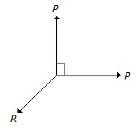A force acting on a body may
Change its motion
Balance the other forces acting on it
Retard its motion
All of the above
Correct Answer :
D. All of the above
Related Questions
When a rigid body is suspended vertically, and it oscillates with a small amplitude under the action of the force of gravity, the body is known as
Simple pendulum
Compound pendulum
Torsional pendulum
Second's pendulum
From a circular plate of diameter 6 cm is cut out a circle whose diameter is a radius of the plate. Find the e.g. of the remainder from the centre of circular plate
0.5 cm
1.0 cm
1.5 cm
2.5 cm
The unit of moment of inertia of an area is
kg-m2
kg-m-s2
kg/m2
m4
Pick up wrong statement about friction force for dry surfaces. Friction force is
Proportional to normal load between the surfaces
Dependent on the materials of contact surface
Proportional to velocity of sliding
Independent of the area of contact surfaces
One kg force is equal to
7.8 N
8.9 N
9.8 N
12 N
Which of the following is a scalar quantity?
Force
Speed
Velocity
Acceleration
The velocity ratio for the first system of pulleys is (where n is the number of pulleys.)
n
n²
2n
2n - 1
The forces, whose lines of action are parallel to each other and act in the same directions, are known as
Coplanar concurrent forces
Coplanar non-concurrent forces
Like parallel forces
Unlike parallel forces
The moment of inertia of a thin spherical shell of mass m and radius r, about its diameter is
mr2/3
2mr2/3
2mr2/5
3mr2/5
The centre of gravity a T-section 100 mm × 150 mm × 50 mm from its bottom is
50 mm
75 mm
87.5 mm
125 mm
Which of the following is not a scalar quantity?
Mass
Volume
Density
Acceleration
The centre of percussion is below the centre of gravity of the body and is at a distance equal to
h/kG
h2/kG
kG2/h
h × kG
In order to double the period of simple pendulum, the length of the string should be
Halved
Doubled
Quadrupled
None of these
The resultant of two equal forces P making an angle θ, is given by
2P sinθ/2
2P cosθ/2
2P tanθ/2
2P cotθ/2
The algebraic sum of moments of the forces forming couple about any point in their plane is
Equal to the moment of the couple
Constant
Both of above are correct
Both of above are wrong
A smooth cylinder lying on its convex surface remains in __________ equilibrium.
Stable
Unstable
Neutral
None of these
Which of the following is not the unit of work, energy and heat?
kcal
kg-m
kW-hr
h.p
If the masses of both the bodies, as shown in the below figure, are doubled, then the acceleration in the string will be 
Same
Half
Double
None of these
The forces which do not meet at one point and their lines of action do not lie on the same plane are known as
Coplanar concurrent forces
Coplanar non-concurrent forces
Non-coplanar concurrent forces
None of these
The velocity ratio of a first system of pulleys with 4 pulleys is
4
8
16
20
A redundant frame is also called __________ frame.
Perfect
Imperfect
Deficient
None of these
Which of the following is not a vector quantity?
Weight
Velocity
Acceleration
Force
If a rigid body is in equilibrium under the action of three forces, then
These forces are equal
The lines of action of these forces meet in a point
The lines of action of these forces are parallel
Both (B) and (C) above
The centre of gravity of a semi-circle lies at a distance of __________ from its base measured along the vertical radius.
3r/ 8
4r/ 3π
8r/3
3r/4π
When a person, on a bicycle, drives round a curve, he has to lean __________ to maintain equilibrium.
Inward
Outward
Towards front
Towards back
Pick up the incorrect statement from the following:
The C.G. of a circle is at its centre
The C.G. of a triangle is at the intersection of its medians
The C.G. of a rectangle is at the intersection of its diagonals
The C.G. of a semicircle is at a distance of r/2 from the centre
The velocity ratio in case of an inclined plane inclined at angle θ to the horizontal and weight being pulled up the inclined plane by vertical effort is
sinθ
cosθ
tanθ
cosecθ
The bellow figure shows the two equal forces at right angles acting at a point. The value of force R acting along their bisector and in opposite direction is 
P/2
2P
√2 × P
P/√2
Non-coplanar concurrent forces are those forces which
Meet at one point, but their lines of action do not lie on the same plane
Do not meet at one point and their lines of action do not lie on the same plane
Meet at one point and their lines of action also lie on the same plane
Do not meet at one point, but their lines of action lie on the same plane
During elastic impact, the relative velocity of the two bodies after impact is __________ the relative velocity of the two bodies before impact.
Equal to
Equal and opposite to
Less than
Greater than
